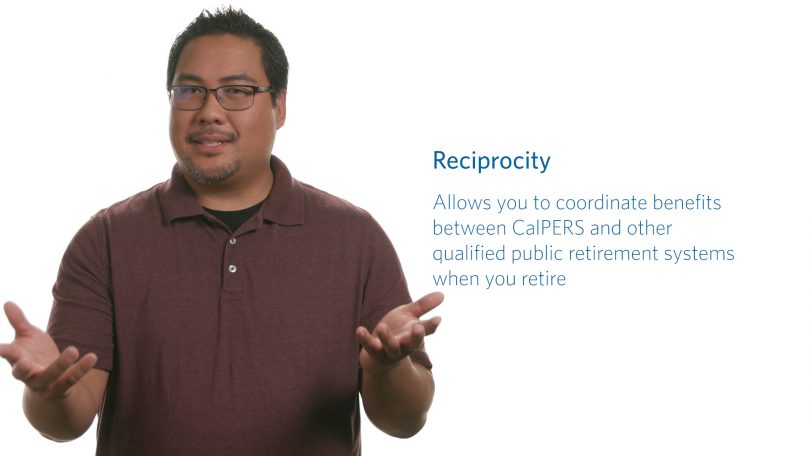Reciprocity is an agreement among California public retirement systems allowing you to move from one qualified public retirement system to another qualified public retirement system (within six months with no overlap in service) without losing some valuable retirement and related benefit rights.
Changing Retirement Systems
Since CalPERS has reciprocal agreements with several other public retirement systems, you may be able to take advantage of reciprocity benefits—which is important if you’re considering changing retirement systems. If you are, make sure to talk to both retirement systems about the advantages and disadvantages of leaving one retirement system and moving to another. Your reciprocal membership may also have an impact on your retirement benefit enrollment level and retirement formula in the system you are entering.
With reciprocity, there is no transfer of funds or service credit between the systems. You would become a member of both systems and be subject to the membership, benefits, and rights of each system. To be eligible for reciprocity, you must be a member of the defined benefit plan in both systems and leave your service credit and contributions on deposit.
Since you are a member of both systems, reciprocity may allow such benefits as using service credit under both retirement systems to meet the eligibility and vesting requirements of each plan. Under reciprocity, each retirement system has its own benefits and vesting requirements.
Final Compensation Exchange
Reciprocity may also allow for the benefit of final compensation exchange if you retire on the same date under both systems. Final compensation exchange allows for your highest compensation earnable and pensionable compensation under either system to be shared to determine if that final compensation can be used in your retirement benefit calculation. For your final compensation to be used to calculate your CalPERS benefit, it will be reviewed upon concurrent retirement to ensure compliance with the Public Employees’ Retirement Law. Laws regarding compensation differ from one system to another, so it’s important to understand each system’s requirements.
At retirement, you must have maintained your membership in the first retirement system by leaving your service credit and contributions on deposit and then apply to retire from each retirement system separately with the same effective retirement date. You’ll then get separate benefit checks from each retirement system.
Protect Your Rights
If you’re changing retirement systems, there are certain conditions you must satisfy to receive the benefit of reciprocity. Our publication When You Change Retirement Systems (PUB 16) (PDF) can provide you with more information on reciprocity. If you have questions about your CalPERS retirement benefits, call us at 888 CalPERS (or 888-225-7377). Questions about rights, benefits, and obligations under any other public retirement system should be addressed directly to that system.
Request Reciprocity Online
If you would like to make a request to establish reciprocity, you can now submit your request simply by logging in to your myCalPERS account and navigating to the reciprocity section, under Retirement Summary. If you submit a request online, you will also be able to view your request status in myCalPERS and know when the determination is complete.
Learn More
Our Quick Tip video on reciprocity gives answers to your most common questions. Watch the video on our YouTube channel and subscribe to the CalPERS Quick Tip series for more helpful tips about your benefits.

